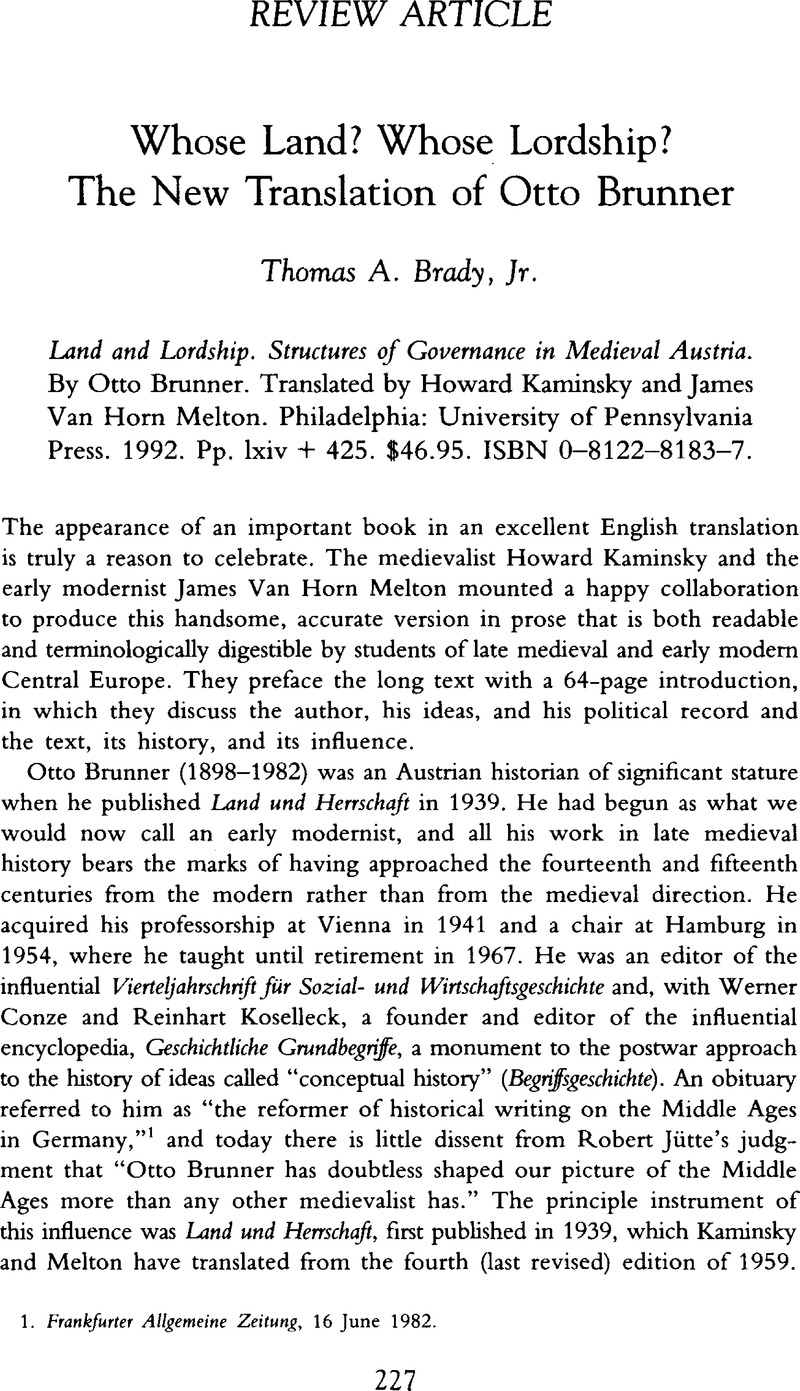Article contents
Whose Land? Whose Lordship? The New Translation of Otto Brunner
Published online by Cambridge University Press: 16 December 2008
Abstract

- Type
- Review Article
- Information
- Copyright
- Copyright © Conference Group for Central European History of the American Historical Association 1996
References
1. Frankfurter Allgemeine Zeitung, 16 June 1982.
2. Jütte, Robert, “Zwischen Ständestaat und Austrofaschismus. Der Beitrag Otto Brunners zur Geschichtsschreibung,” Jahrbuch des Instituts für Deutsche Geschichte 13 (1984): 237–62, here at p. 237.Google Scholar
3. The translators capitalize this term and put it in italics, a good device for distinguishing the peculiar meaning Brunner gives it.
4. Presumably, had Brunner extended his study to include the Swabian-Alemannic region of the southwest, a very much more complex picture would have resulted.
5. It is worth to point out that this is a “socialization” of vassalage even more radical than that advocated by Marc Bloch.
6. The issues are dealt with in a broadly European context in “Introduction: Renaissance and Reformation, Late Middle Ages and Early Modern Era,” in Handbook of European History, 1400–1600. Late Middle Ages, Renaissance, Reformation, ed. Brady, Thomas A. Jr, Oberman, Heiko A., and Tracy, James D., 2 vols. (Leiden, 1994–1995), 1: xiii–xiv.Google Scholar
7. See Brady, Thomas A. Jr, “‘Special Path’? Peculiarities of German Histories in the Early Modern Era,” in Germania Illustrata: Essays on Early Modern Germany Presented to Gerald Strauss, edited by Karant-Nunn, Susan and Fix, Andrew, Sixteenth Century Studies and Essays, vol. 18 (Kirksville, Mo., 1992), 197–216.Google Scholar
8. See Anderson, Margaret Lavinia, “The Limits of Secularization: On the Problem of the Catholic Revival in Nineteenth-Century Germany,” The Historical Journal 38 (1995): 647–70.CrossRefGoogle Scholar
9. Nipperdey, Thomas, Deutsche Geschichte 1800–1860. Bürerwelt und starker Staat (Munich, 1983), 11.CrossRefGoogle Scholar
10. It could be argued that the chief works of Mack Walker and David Sabean, cited below, promote this “ultra-Brunnerian” tendency by placing the definitive end of late medieval tendencies in the Bismarckian era. Walker, Mack, German Home Towns: Community, State, and General Estate, 1648–1871 (Ithaca, 1971);Google ScholarSabean, David W., Property, Production, and Family in Neckarhausen (Cambridge, 1991).CrossRefGoogle Scholar The relationship of neither book to Brunner's chief work is direct, and Sabean's conception of rural history, it seems to me, owes far more to Karl Siegfried Bader than it does to Brunner. Based, admittedly, on far better sources, Sabean carries the analysis of lordship into the household and confronts its fundamental issues—gender and generations—as Brunner never did.
11. For example, Carl Schmitt, to which the translated version makes four references, three positive (pp. 14, 95–96) and one negative (p. 31).
12. Lehmann, Hartmut and Van Horn Melton, James, eds., Paths of Continuity: Central European Historiography from the 1930s to the 1950s (Cambridge and Washington, D.C., 1994), which contains a valuable study of Brunner by Melton.CrossRefGoogle Scholar
- 1
- Cited by




